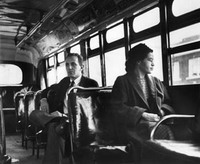Login form
Civil Rights Movement

Rosa Parks was tired. She’d had a long day at work, and all she wanted to do was sit down and rest her aching feet. But the bus driver on the way home ordered her to get up. The driver wanted to give her seat to a white man who had just gotten on the bus. Parks was black, and black people were expected to move to the back of the bus or even stand up so that white people could sit.
On that particular day, December 1, 1955, Parks decided she’d had enough. She refused to give up her seat, and the police in Montgomery, Alabama, arrested her for it! Parks did not start the civil rights movement. But her arrest played an important role in the struggle for equal black rights in the United States.
SEGREGATION AND DISCRIMINATION
Before the civil rights movement, black people were often not treated fairly in the United States. A system of segregation kept white and black people apart in many Southern states. Under segregation, blacks and whites had to use separate public facilities, such as schools, hospitals, and restrooms. Facilities for white people got more money from the government and were generally much nicer than facilities for blacks. Teachers at white schools were paid more money. White hospitals had more doctors. Southern states kept black people from voting so that black people would have no say in government.
African Americans living in Northern states could vote. But they still suffered from discrimination (unfair treatment). The best jobs, housing, and education went to white people.
THE MONTGOMERY BUS BOYCOTT
The day after Parks was arrested, Montgomery’s black residents organized a protest against their poor treatment on city buses. They refused to ride Montgomery buses. Instead, they walked or organized car pools. This kind of protest is called a boycott. Many people consider the Montgomery bus boycott to be the beginning of the civil rights movement.
Local black leaders chose a young Baptist minister as the boycott’s spokesman. The minister was Dr. Martin Luther King, Jr. King became one of the greatest leaders of the civil rights movement.
Parks took her case to court. Nearly a year after the boycott began, the Supreme Court of the United States ruled that segregated public buses and trains were illegal.
COURT DECISIONS WEREN’T ENOUGH
The Supreme Court’s decision did not end segregation. Segregation continued in stores, restaurants, and other privately owned places.
Even in public places, the Court’s decisions were not immediately obeyed. In a case known as Brown v. Board of Education, the Supreme Court had ruled in 1954 that segregated schools were often unequal and therefore were illegal. The ruling raised hopes that segregation would soon end. But school principals and even state governors refused to obey the Supreme Court.
In 1957, President Dwight Eisenhower had to send federal soldiers to escort nine black students safely into a white high school in Little Rock, Arkansas.
THE MOVEMENT GROWS
King and other civil rights leaders organized nonviolent marches, boycotts, and demonstrations against segregation all over the South. Black college students in Greensboro, North Carolina, protested segregation with a series of sit-ins beginning in 1960. They sat at lunch counters that only served white people, and they refused to leave unless they were served. These protests, known as sit-ins, spread to other cities.
Civil rights workers called Freedom Riders rode buses across the South in 1961 to test segregation at bus stations. They were attacked by a white mob in Alabama. The attackers burned a bus and severely beat some of the Freedom Riders.
In 1963, “Bull” Connor, police commissioner of Birmingham, Alabama, ordered his police force to turn fire hoses and unleash police dogs on civil-rights protestors. Hundreds of schoolchildren were among the protestors. Television and newspapers widely reported the police attacks on black children. Many Americans were horrified.
MARCH ON WASHINGTON
In August of 1963, more than 200,000 people joined in a march on the nation’s capital in Washington, D.C. The marchers heard King give his famous “I Have a Dream” speech from the steps of the Lincoln Memorial.
That massive march helped persuade the U.S. Congress to pass the Civil Rights Act of 1964. The act prohibited discrimination in education, jobs, and public accommodations, such as hotels and restaurants.
VOTING RIGHTS ACT OF 1965
In 1964 the Ku Klux Klan, a white terrorist group, murdered three young workers who were helping black people in Mississippi register to vote.
In Alabama, the police attacked and beat a group of civil rights activists who were marching to Montgomery, the state capital, to protest the lack of voting rights for black citizens.
Newspapers and television stations widely reported the shocking violence. Those reports helped win passage of the Voting Rights Act of 1965. The act made it much easier for African Americans to vote.
THE MOVEMENT ENDS
Some people believe the Civil Rights Act and the Voting Rights Act marked the end of the civil rights movement. Those two acts granted the basic rights that African Americans were seeking. Others say the movement ended in 1968 when a sniper murdered King in Memphis, Tennessee.
Source: Microsoft ® Encarta

